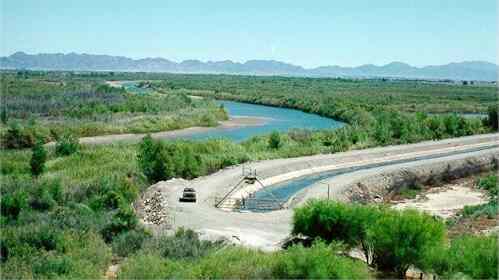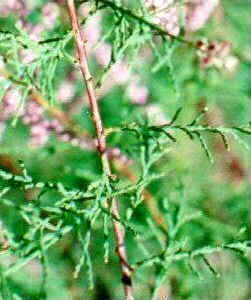TAMARISK (Tamarix species) Tamarisks (Tamarix ramosissima and T. parviflora in the USA) are shrubby trees that grow to 5 or 6 metres height. They are native to Africa, Asia and Europe, but were introduced into the USA in the 1800s for hedging or ornamental purposes, and have now spread widely along water courses in the drier, western regions of the USA, causing significant ecological disruption. So, tamarisks are classic examples of invasive aliens.
In many parts of the arid southwestern USA, the dry or temporary river courses, or man-made irrigation canals, are now dominated by tamarisks, as in the image above. Tamarisks produce dense thickets that crowd out native willows and other riparian vegetation. They also spread rapidly because they flower profusely and produce many thousands of small seeds, which can be spread rapidly and germinate immediately to cover any bare soil. The plant can also propagate from buried buried or submerged stems.
Once tamarisks are established in a site they are very tolerant of drought conditions. But they are also very "thirsty" plants which use a lot of water when it is available, transpiring at a high rate and therby causing the soil to become saline. A consequence of this is that the groundwater levels are reduced, with significant impact on water conservation in arid regions. This behaviour stems from the fact that these non-native plants are not adapted physiologically for water conservation - unlike the typical plants of desert regions. Conservation dilemmas The control of tamarisk is desirable not only because of its impact on native riparian plants but also because dense tamarisk stands support significantly fewer species of birds and other wild animals, thereby reducing biodiversity. A combination of management practices, including burning, physical removal, and re-establishment of native plant communities are required for effective control of tamarisk. Recently, a new approach has been initiated, by releasing an exotic beetle as a biological control agent to bring tamarisk populations under control. This beetle - the Chinese leaf beetle - has been found to eat only saltcedars and thus is thought to pose no threat to other desert plants. Even so, in the initial stages of this programme the beetle is only being released onto caged plants, to monitor its effects and prevent its potential uncontrolled spread into wild populations [see First Biological Control Agent for Saltcedar Released (not on this server)]. A further problem has set conservationists against one another, because saltcedars now provide the habitat and nesting sites for the most endangered songbird in North America - the southwestern willow flycatcher. If saltcedar were to be eliminated without providing alternative habitat then this rare bird would be lost. This conflict of interests needs to be addressed carefully, by conserving saltcedar in those sites where the flycatcher is known to occur, while progressively removing saltcedar from other areas and re-establishing the native cottonwood and willow populations, which the flycatchers used to inhabit. LINKS (not on this server): |



